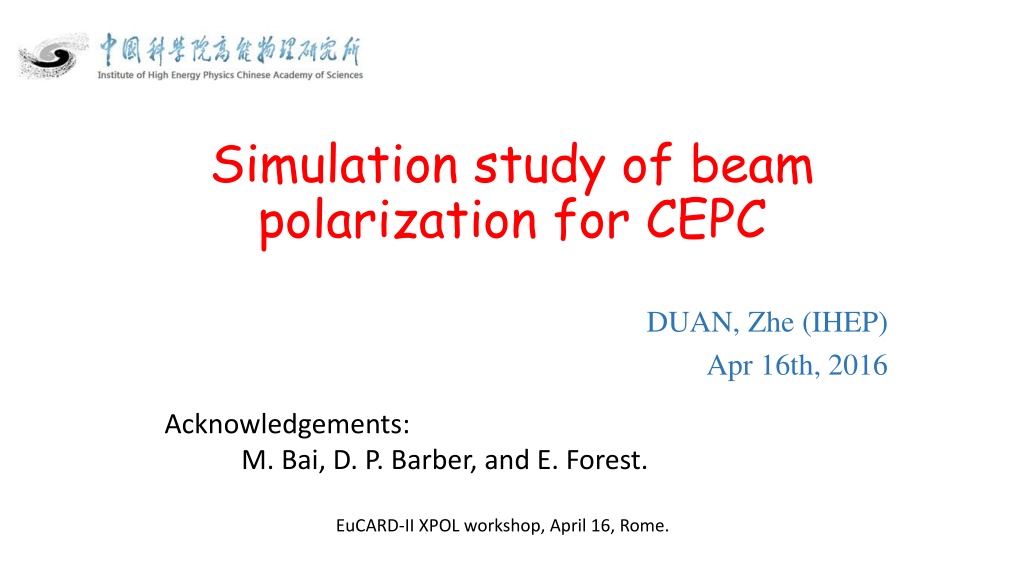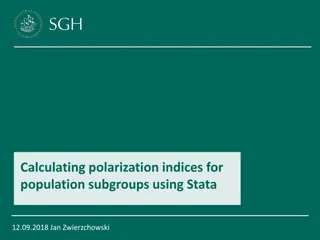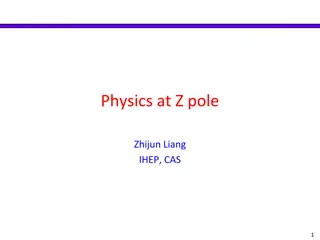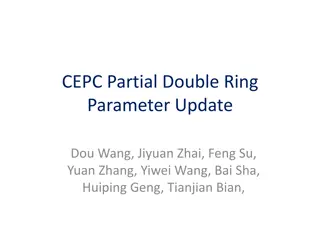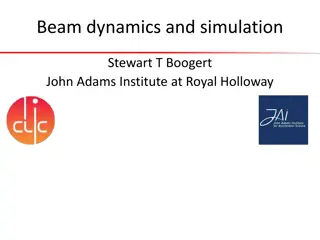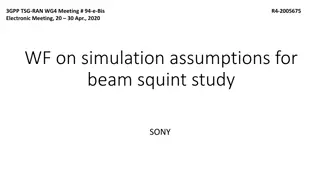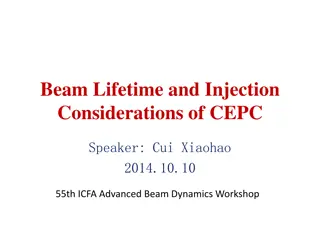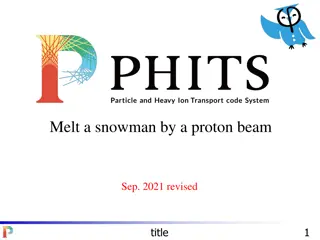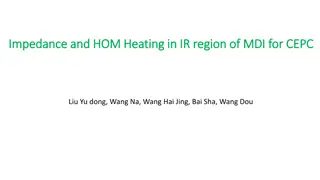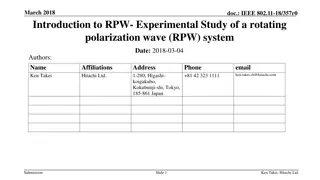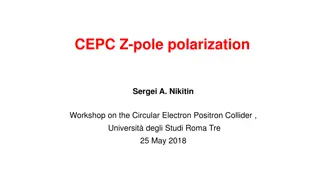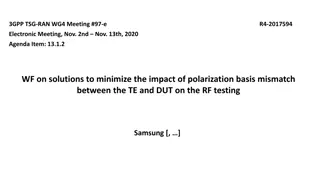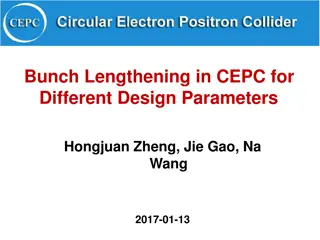Beam Polarization Simulation Study for CEPC
Simulation study on beam polarization for the Circular Electron Positron Collider (CEPC) using the PTC Poly- morphic Tracking Code. The study includes orbital and spin tracking, equilibrium polarization calculation, and Monte-Carlo simulation of depolarization rate. Comparison with other Monte-Carlo simulation codes is discussed along with lattice imperfection introduction and correction techniques.
Uploaded on Sep 22, 2024 | 0 Views
Download Presentation

Please find below an Image/Link to download the presentation.
The content on the website is provided AS IS for your information and personal use only. It may not be sold, licensed, or shared on other websites without obtaining consent from the author. Download presentation by click this link. If you encounter any issues during the download, it is possible that the publisher has removed the file from their server.
E N D
Presentation Transcript
Simulation study of beam polarization for CEPC DUAN, Zhe (IHEP) Apr 16th, 2016 Acknowledgements: M. Bai, D. P. Barber, and E. Forest. EuCARD-II XPOL workshop, April 16, Rome.
Outline Simulation Tool Preliminary simulation results for 45 & 80GeV Simulation study for ultra-high beam energies & comparison with theories[1] Conclusion [1] Z. Duan, M. Bai, D. P. Barber and Q. Qin, NIM A793 (2015) 81.
Polarization Simulation with PTC Polymorphic Tracking Code(PTC) [1] is capable of orbital & spin tracking, as well as normal form analysis of one turn map. Lattice imperfection & correction can be implemented with MADX or BMAD and exported to PTC format. Fortran scripts are developed calling PTC as a library. Equilibrium polarization calculation including first order spin resonances: First order normal form to obtain and , then apply DK formula.[2] Equilibrium polarization calculation including higher order spin resonances. Monte-Carlo simulation of depolarization rate, similar to SITROS & SLICKTRACK. This is essential for higher beam energy as in CEPC and FCC-ee. [1] F. Schmit, E. Forest and E. McIntosh, CERN-SL-2002-044, 2002. [2] E. Forest, KEK Report KEK-2010-39, 2010.
Comparison of Monte-Carlo simulation code Code\features orbit map Photon emission Speed 2nd order matrix SITROS Big photon localized at several points 1st order matrix SLICKTRACK Big photon localized at several points PTC nonlinear symplectic integrator at each integration step of each dipole. much slower compared to the others. It is not clear now if the more precise treatment in PTC have large effects on the simulation results. The lumped treatment in SITROS & SLICKTRACK can also be implemented within PTC with some effort.
Model Ring Arc FODO cells of phase advances 60/60 degrees, connected by straight FODO cells; Periodicity: 4. Circumference: 50294.4m. No polarization wigglers yet. Same lattice for Z & W. Parameters \ Energy Range Z W energy(GeV) / a 45.6 / 103.5 80.4/182.5 working point Qx/Qy/Qz natual emittance(nm) 236.08/236.22/0.0286 236.08/236.22/0.05 0.58 1.81 damping time (turn) x/ y/ z rms energy spread (10-4) rms energy spread (MeV) polarization build-up time(hour) 1511/1511/756 276/276/139 5.3 9.4 24.2 75.6 41.4 2.43 spread of spin precessing rate =a modulation index = /Qz 0.055 0.172 1.9 3.43
Lattice imperfection introduction & correction In MADX, vertical misalignment errors are introduced for each quadrupole(2736 quads in total), with a rms ymis = 50 m, correction is also done in MADX. Near each quad, there is a zero-length BPM & and a H/V corrector of 0.05m. BPM error is not introduced yet. MICADO algorithm is used to correct vertical orbit only, different number of correctors used in MICADO correspond to different final rms vertical closed orbit & rms tilt of n0-axis. Harmonic closed orbit spin matching is not implemented yet. Increase in the rms tilt of n0-axis generally leads to increase of and therefore a reduction in equilibrium beam polarization.
45.5GeV Uncorrected ycorms = 1.388 mm Corrected with 50 correctors in MICADO ycorms = 0.161564 mm The closed orbit spin tune shifts a lot in this particular case of 45.5GeV.
45.5&80GeV, n0-axis tilt vertical dispersion number of correctors in MICADO ycorms (mm) dyrms emittance ratio (mm) uncorrected 1.388 91.8 0.248 50 0.162 13.8 0.0079 200 0.078 1.79 0.0003 500 0.048 1.77 0.0002
45.5&80GeV, first order calculation of polarization vertical dispersion number of correctors in MICADO ycorms (mm) dyrms emittance ratio (mm) uncorrected 1.388 91.8 0.248 50 0.162 13.8 0.0079 200 0.078 1.79 0.0003 500 0.048 1.77 0.0002 The closed orbit spin tune shifts a lot in this particular case of 45.5GeV.
80GeV Corrected with 200 correctors in MICADO ycorms = 0.069 mm Corrected with 500 correctors in MICADO ycorms = 0.03 mm
Discussion As shown above, one particular case of misaligned ring & orbit correction was passed to polarization simulation. For a specified misalignment error setting in quads, a lot of different random seeds are needed to feed the polarization simulation, to get a statistical understanding. Note that the step size is too large to exhibit synchrotron sideband resonances in the simulation, which also needs improvement. For the same lattice, the same vertical orbit distortion, tilt of n0-axis scales with beam energy, enhancement factor due to synchrotron sidebands increase with beam energy as well. The upper limit of beam energy with useful polarization is set by the machine alignment precision and orbital correction capability. On the other hand, polarization can be regarded as one criterion on lattice error tolerance studies. Lattice processed by practical modeling of different error sources and the state of art error corrections should be passed to polarization simulation to get a reliable understanding.
Theoretical overview for ultra-high beam energies Derbenev, Kondratenko and Skrinsky s work dates back to 1970s.[1] Higher order resonances (primarily synchrotron sidebands) become dominant at ultra-high beam energies. First order theory no longer suffices. Different regimes of spin diffusion: Correlated resonance crossing: the width of synchrotron sideband is smaller than the synchrotron resonance spacing. (consistent with observations in LEP) Uncorrelated resonance crossing: the width of synchrotron sideband is larger than the synchrotron resonance spacing, different behaviors when the spread of spin precessing rate is much smaller or much larger than 1. (CEPC & FCC-ee might enter this regime.) [1] Y. Derbenev, A. Kondratenko, A. Skrinsky, Particle Accelerators 9 (1979) 247.
DK theory (correlated regime) Away from spin resonances[1] Synchrotron sideband resonances[2] : The equilibrium beam polarization can be estimated with [1] Y. Derbenev, A. Kondratenko, Sov. Phys. JETP 37 (1973) 968. [2] S. Mane, Nucl. Instrum. Meth. A292 (1990) 52.
DK theory (uncorrelated regime)[1,2] Near a spin resonance, stochastic photon emissions should contribute to the depolarization rate[2], which is generally small if the spread of spin precessing rate is small, and we don t run a machine near major spin resonances. If the rms spread in spin phase advance in a synchrotron oscillation period is large ( correlation index > 1), and the rms spread of the spin precession frequency is larger than synchrotron tune: The spin resonances completely overlap and are unavoidable. The crossings of resonances during synchrotron motion are completely uncorrelated. The depolarization rate is described by Not clear if the first term in + still holds, and can be added to the latter term.
Simulation study of a model ring A ring of arc FODO cells connected by FODO straight sections, Periodicity = 4. Four skew quads are symmetrically inserted to drive horizontal & vertical spin resonances. No lattice imperfections.
Discussion The simulation results support the theory of uncorrelated regime at ultra-high beam energies. LEP2 @ 104GeV and FCC-ee 175GeV operation is expected to be within this regime. LEP2 didn t observe useful polarization at such a high beam energy. This study shows there are still some open questions to be answered theoretically, which is now under investigation by D. P. Barber, J. A. Ellison, and K. Heinemann. Siberian snakes are not taken into account in this study, which would change the picture totally.
Conclusion Monte-Carlo simulation of beam equilibrium polarization is set up with error & corrections at Z&W. More work is needed to implement more practical error settings and correction schemes. Monte-Carlo simulations of a model ring at ultra-high beam energies support DKS s theory of correlated & uncorrelated regimes, qualitatively. Better understanding of the theories is needed.
